Email marketing remains one of the most effective and cost-efficient strategies for businesses of all sizes to engage with their audience, drive conversions, and build long-term customer relationships. However, understanding the costs associated with email marketing can be complex due to the multitude of factors involved. This comprehensive guide delves into the various components of email marketing expenses, explores lesser-known but highly effective strategies to optimize costs, and highlights how innovative tools like Prism Reach can enhance your email marketing efforts without breaking the bank.
Key Facts About Email Marketing Costs
- ESP Fees: Ranging from $0 to $99+ per month, depending on list size and features.
- Agency Services: Can cost between $300 to $12,000+ monthly, based on business size and needs.
- Design and Copywriting: Expenses can vary from $30 to $2,000 per email or hour.
- List Building: Costs between $2.50 to $20 per contact, depending on methods and lead quality.
- Compliance Costs: Expenses for GDPR and CCPA compliance, including legal consultations and consent management tools.
- Analytics Tools: Basic analytics often included, but advanced tools can add to the overall cost.
Upgrade Your Email Marketing with AI Personalization!
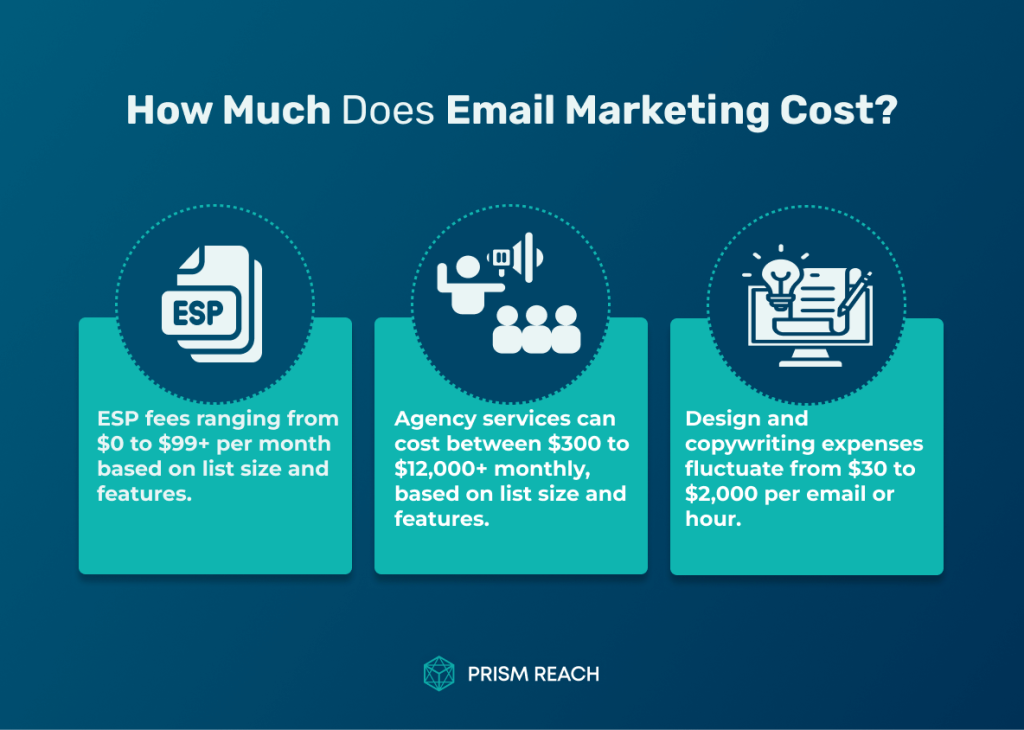
Decoding the Complexities of Email Marketing Expenses
Email marketing costs can vary widely based on several key factors. Understanding these can help businesses budget effectively and maximize their return on investment (ROI).
Primary Components of Email Marketing Costs
The main components influencing email marketing costs include:
- Email Service Provider (ESP) Fees: ESPs charge based on the number of subscribers or the volume of emails sent. Prices range from free for basic services to thousands of dollars per month for enterprise solutions.
- Design and Copywriting: High-quality, custom-designed emails and compelling copy can significantly enhance engagement but come at a higher cost.
- List Building and Maintenance: Acquiring and maintaining a healthy email list involves ongoing expenses, including list cleaning services to ensure deliverability.
- Compliance with Privacy Regulations: Ensuring compliance with laws like GDPR and CCPA requires investments in legal consultations, consent management tools, and data protection measures.
- Analytics and Reporting Tools: While basic analytics are often included with ESPs, advanced reporting tools provide deeper insights and come at an additional cost.
How List Size and Campaign Frequency Affect Costs
The size of your email list and the frequency of your campaigns are major drivers of email marketing costs:
- Campaign Frequency: More frequent email sends mean higher costs for content creation, design, and potentially higher ESP fees. Balancing send frequency to maintain engagement without causing email fatigue is crucial.
- List Size: Most ESPs charge based on the number of subscribers. For example, managing a list of up to 5,000 contacts might cost anywhere from $0 to $99 per month, but costs escalate significantly as your list grows beyond 10,000 or 50,000 subscribers.
Hidden Costs in Email Marketing
Beyond the obvious expenses, several hidden costs can impact your email marketing budget:
- List Cleaning Services: Maintaining deliverability by removing inactive subscribers can cost between $50 to $1,000, depending on list size and service quality.
- Integration Costs: Connecting your ESP with other marketing tools like CRM systems or e-commerce platforms may require developer time or specialized software.
- A/B Testing Expenses: Comprehensive testing to optimize campaigns can require additional design and copywriting resources, as well as more sophisticated analytics tools.
- Staff Training: Educating your team on new email marketing tools and strategies can incur costs, especially as technologies evolve.
- Maintaining Email Deliverability: Investing in authentication protocols like SPF, DKIM, and DMARC, as well as regular monitoring, helps avoid spam filters but adds to the overall cost.
Integrating Hidden Gems to Optimize Email Marketing Costs
To effectively manage and reduce email marketing costs without sacrificing quality, consider implementing the following lesser-known but highly effective strategies:
1. Leverage Tiered CPM Rates
Negotiate tiered CPM (Cost Per Mille) rates with your Email Service Provider (ESP). As your email volume increases, your CPM rate decreases, leading to significant savings for high-volume senders. This strategy is particularly beneficial for businesses expecting rapid growth in their email lists.
2. Implement a Hybrid Tool Strategy
Utilize a combination of a more affordable tool for basic broadcasts and a more advanced tool for behavior-based automation. This hybrid approach optimizes costs while maintaining sophisticated functionality, allowing you to tailor your tools to specific campaign needs.
3. Unbundle All-in-One Platforms
Replace expensive all-in-one CRM platforms with a combination of dedicated tools. For example, use Prism Reach for customer communications and Help Scout for support. This unbundling can lead to significant cost reductions while ensuring each tool is optimized for its specific function.
4. Utilize Package-Based Pricing for Seasonal Campaigns
Offer special package-based pricing for peak seasons to attract short-term clients who need high-impact campaigns without long-term commitments. This strategy allows you to maximize revenue during busy periods while keeping costs manageable.
5. Automate Unsubscriptions and Email Validations
Set up automation for complete unsubscriptions and email address error validations. This reduces unnecessary sending costs and minimizes the risk of legal issues from sending emails to unsubscribed contacts. Automation ensures your email list remains clean and engaged.
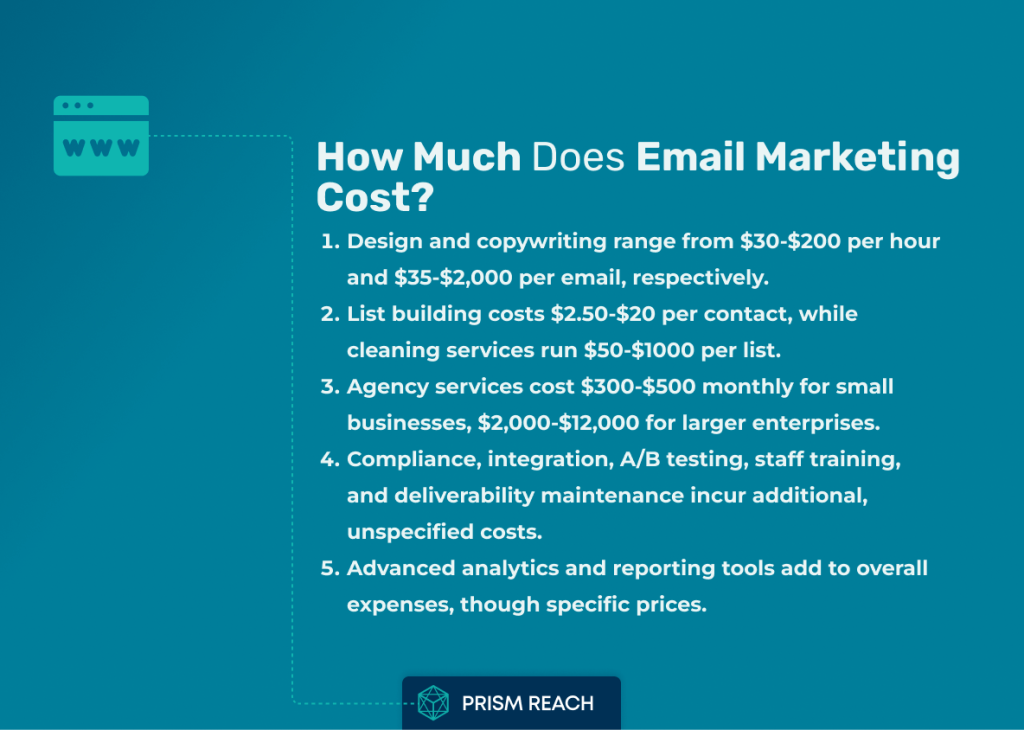
In-House vs. Outsourcing: What’s More Cost-Effective?
Deciding whether to handle email marketing in-house or outsource it depends on your business size, expertise, and resources:
- In-House Management: Suitable for small businesses with limited campaigns. It allows for greater control and can be more budget-friendly if you have team members with the necessary skills.
- Outsourcing to Agencies: Beneficial for larger businesses or those with complex campaigns. Agencies bring specialized knowledge and resources, potentially offering better ROI through expertise and efficiency.
- Hybrid Approach: Combining in-house operations with external expertise can provide the best of both worlds. Handle day-to-day tasks internally while leveraging agencies for strategy development and advanced campaign creation.
Tools like Prism Reach offer a middle ground by providing advanced features and automation that can reduce the need for extensive in-house resources, making outsourcing a more viable and cost-effective option.
Measuring the ROI of Your Email Marketing Spend
Understanding the ROI of your email marketing efforts is crucial for justifying the investment and optimizing future campaigns. Here’s how to effectively measure ROI:
- Track Key Metrics: Monitor open rates, click-through rates, conversion rates, and unsubscribe rates. These metrics provide insights into the effectiveness of your campaigns.
- Tie Metrics to Revenue: Link your email metrics to actual sales and revenue generated. This can be achieved through proper tracking and attribution models.
- Calculate Customer Lifetime Value (CLV): Determine the long-term value of subscribers acquired through email marketing to justify the initial investment.
- Use Advanced Analytics: Tools like Prism Reach offer detailed analytics that provide deeper insights into subscriber behavior and campaign performance, enabling more accurate ROI calculations.
By accurately measuring ROI, businesses can make informed decisions about where to allocate resources and how to optimize their email marketing strategies for maximum impact.
Strategies to Reduce Email Marketing Costs Without Sacrificing Quality
Optimizing email marketing costs involves a combination of smart strategies and leveraging the right tools. Here are some effective approaches:
- Automate Repetitive Tasks: Streamlining workflows through automation reduces the time and resources needed for campaign management. Prism Reach’s automation capabilities can handle tasks like personalized content generation and scheduling, freeing up your team to focus on strategic initiatives.
- Use AI-Powered Personalization: Implementing AI-driven personalization enhances engagement rates without the need for extensive manual segmentation. Prism Reach’s AI algorithms create highly individualized experiences for each subscriber, boosting open and click-through rates.
- Focus on List Quality Over Quantity: Maintaining a clean, engaged email list is more cost-effective than constantly acquiring new subscribers. Regularly clean your list to remove inactive contacts, reducing ESP costs and improving deliverability.
- Repurpose Content Across Channels: Transform existing content from blogs, social media, or podcasts into email material. This saves time and resources while engaging a wider audience and driving traffic to other channels.
- Optimize Send Frequency: Tailor the frequency of your emails based on subscriber engagement. Sending fewer, more targeted emails to less engaged subscribers can reduce costs and improve overall engagement rates.
Impact of Privacy Regulations on Email Marketing Costs
Compliance with privacy regulations like GDPR and CCPA introduces additional costs but is essential for maintaining customer trust and avoiding hefty fines:
- Consent Management Tools: Implementing tools to manage subscriber consent can incur costs but are necessary for compliance.
- Legal Consultations: Ensuring your email marketing practices comply with regulations may require legal expertise.
- Data Protection Measures: Investing in robust data protection measures safeguards subscriber information and ensures compliance.
While these compliance costs can be significant, they contribute to better email marketing practices, improved engagement rates, and enhanced deliverability by respecting subscriber preferences.
How to Start Optimizing Your Email Marketing Costs Today
Businesses looking to optimize their email marketing costs can take several immediate steps:
- Audit Your Current Setup: Review your ESP, tools, and processes to identify inefficiencies or unnecessary expenses.
- Clean Your Email List: Remove inactive subscribers to reduce ESP costs and improve deliverability.
- Implement Basic Segmentation: Even simple segmentation can significantly improve engagement without adding much cost.
- Explore Automation: Start with basic automated flows like welcome series or abandoned cart emails to save time and improve relevance.
- Optimize Your Email Design: Create templates that are both visually appealing and quick to customize for different campaigns.
- Focus on Quality Over Quantity: Reduce send frequency to less engaged subscribers and concentrate on creating high-value content for your most active audience.
- Leverage Analytics: Use the data you have to make informed decisions about what’s working and what’s not.
Implementing these strategies can lead to immediate improvements in your email marketing ROI. For those seeking to elevate their email marketing further, advanced solutions like Prism Reach offer the tools and automation needed to optimize costs while enhancing campaign effectiveness.
Benefits of Prism Reach for Cost-Effective Email Marketing
Prism Reach is an innovative AI-powered SaaS solution designed to enhance the effectiveness of email marketing campaigns through deep personalization. Here are three key benefits relevant to managing email marketing costs:
- AI-Powered Personalization: Prism Reach’s sophisticated AI algorithms customize every aspect of newsletters based on subscriber behavior and preferences, leading to higher engagement rates and better ROI.
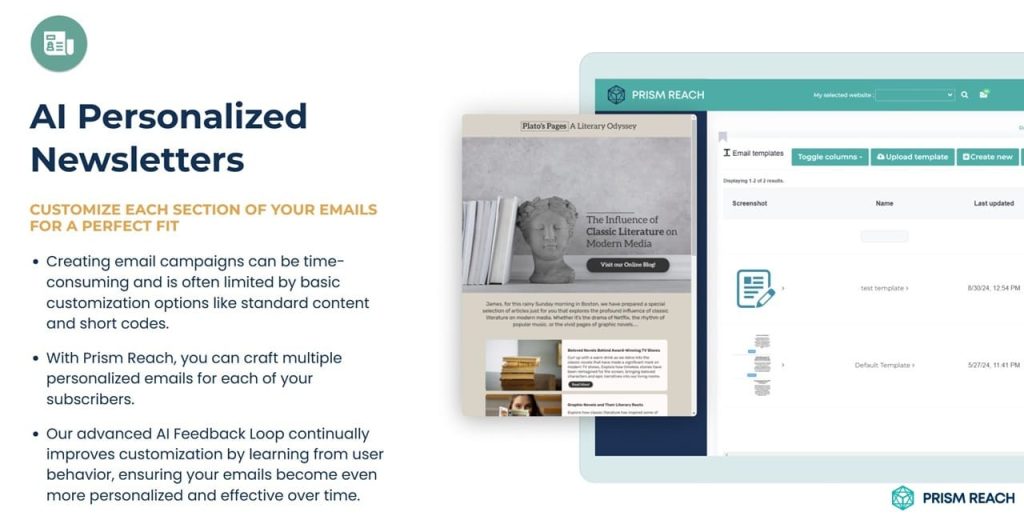
- Automation Capabilities: By automating repetitive tasks such as content generation and scheduling, Prism Reach reduces the time and resources needed for campaign management, allowing businesses to do more with less.
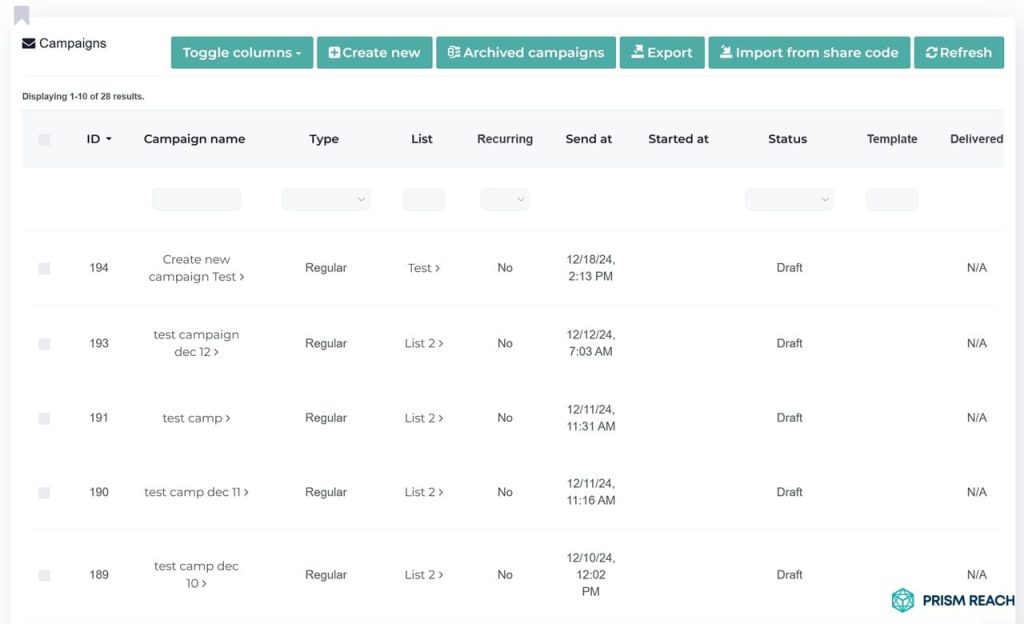
- Advanced Analytics: Prism Reach offers detailed insights into campaign performance and subscriber behavior, enabling more accurate ROI calculations and identifying areas for optimization.
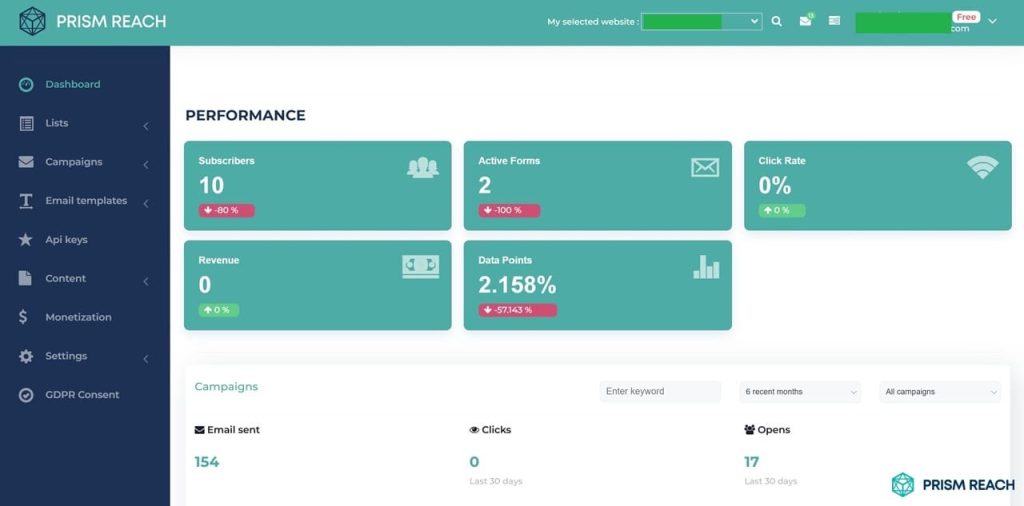
Integrating Prism Reach into Your Email Marketing Strategy
Incorporating Prism Reach into your email marketing strategy can provide significant cost savings and enhance the effectiveness of your campaigns. Here’s how:
- Seamless Setup and Integration: Prism Reach can be integrated within minutes, with one-click uploads facilitating easy migration of existing subscriber lists.
- Dynamic Content Selection: The AI determines the most relevant content for each subscriber, ensuring that every newsletter is personalized and engaging.
- Optimal Sending Times: Predictive analytics determine the best times to send newsletters, maximizing subscriber engagement and reducing the likelihood of emails being ignored.
FAQ
Conclusion
Understanding and managing the costs of email marketing is crucial for businesses aiming to maximize their ROI and build lasting customer relationships. By breaking down the primary components of email marketing expenses, recognizing hidden costs, and implementing effective strategies, businesses can optimize their email marketing efforts without overspending.
Incorporating hidden gems such as leveraging tiered CPM rates, implementing hybrid tool strategies, and automating unsubscriptions can lead to significant cost savings while maintaining high-quality campaigns. Additionally, advanced tools like Prism Reach offer invaluable benefits, including AI-powered personalization, automation capabilities, and detailed analytics, which help businesses enhance engagement rates and streamline their marketing processes.
As the email marketing landscape continues to evolve, staying informed about cost-effective strategies and leveraging innovative technologies will be key to maintaining a competitive edge. Whether you’re a beginner or an advanced marketer, understanding the intricacies of email marketing costs and utilizing the right tools can drive meaningful results for your business.
Remember, effective email marketing is not just about cutting costs but about investing wisely to deliver value to your subscribers and achieve your business goals. With the right approach and tools like Prism Reach, you can navigate the complexities of email marketing costs and create campaigns that are both budget-friendly and highly impactful.